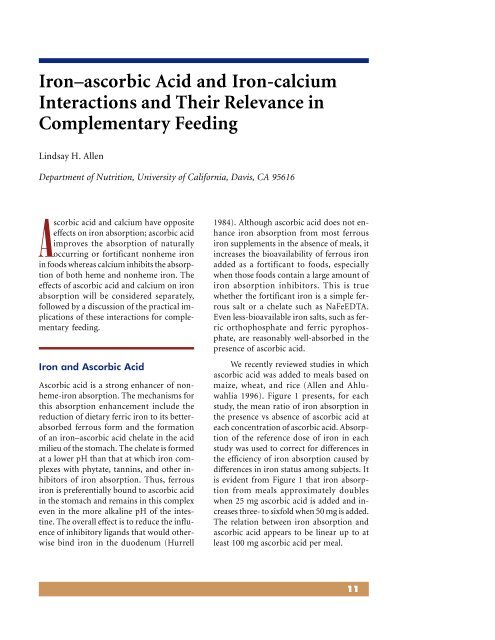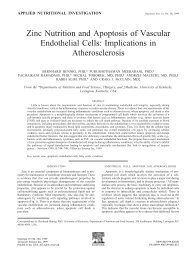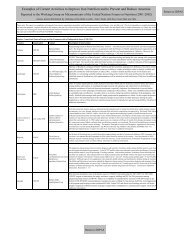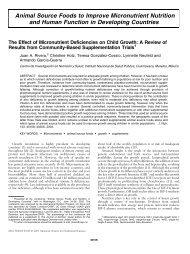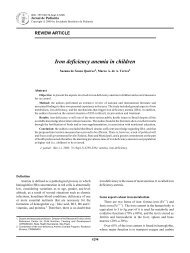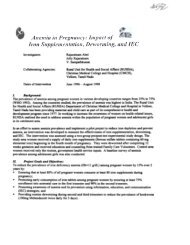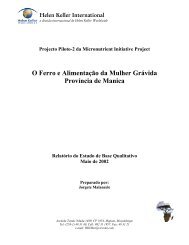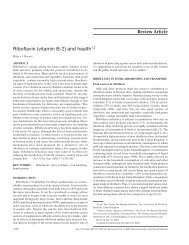Micronutrient Interactions: Impact on Child Health and ... - Idpas.org
Micronutrient Interactions: Impact on Child Health and ... - Idpas.org
Micronutrient Interactions: Impact on Child Health and ... - Idpas.org
Create successful ePaper yourself
Turn your PDF publications into a flip-book with our unique Google optimized e-Paper software.
Ir<strong>on</strong>-zinc-copper <str<strong>on</strong>g>Interacti<strong>on</strong>s</str<strong>on</strong>g><br />
Ir<strong>on</strong>–ascorbic Acid <strong>and</strong> Ir<strong>on</strong>-calcium<br />
<str<strong>on</strong>g>Interacti<strong>on</strong>s</str<strong>on</strong>g> <strong>and</strong> Their Relevance in<br />
Complementary Feeding<br />
Lindsay H. Allen<br />
Department of Nutriti<strong>on</strong>, University of California, Davis, CA 95616<br />
Ascorbic acid <strong>and</strong> calcium have opposite<br />
effects <strong>on</strong> ir<strong>on</strong> absorpti<strong>on</strong>; ascorbic acid<br />
improves the absorpti<strong>on</strong> of naturally<br />
occurring or fortificant n<strong>on</strong>heme ir<strong>on</strong><br />
in foods whereas calcium inhibits the absorpti<strong>on</strong><br />
of both heme <strong>and</strong> n<strong>on</strong>heme ir<strong>on</strong>. The<br />
effects of ascorbic acid <strong>and</strong> calcium <strong>on</strong> ir<strong>on</strong><br />
absorpti<strong>on</strong> will be c<strong>on</strong>sidered separately,<br />
followed by a discussi<strong>on</strong> of the practical implicati<strong>on</strong>s<br />
of these interacti<strong>on</strong>s for complementary<br />
feeding.<br />
Ir<strong>on</strong> <strong>and</strong> Ascorbic Acid<br />
Ascorbic acid is a str<strong>on</strong>g enhancer of n<strong>on</strong>heme-ir<strong>on</strong><br />
absorpti<strong>on</strong>. The mechanisms for<br />
this absorpti<strong>on</strong> enhancement include the<br />
reducti<strong>on</strong> of dietary ferric ir<strong>on</strong> to its betterabsorbed<br />
ferrous form <strong>and</strong> the formati<strong>on</strong><br />
of an ir<strong>on</strong>–ascorbic acid chelate in the acid<br />
milieu of the stomach. The chelate is formed<br />
at a lower pH than that at which ir<strong>on</strong> complexes<br />
with phytate, tannins, <strong>and</strong> other inhibitors<br />
of ir<strong>on</strong> absorpti<strong>on</strong>. Thus, ferrous<br />
ir<strong>on</strong> is preferentially bound to ascorbic acid<br />
in the stomach <strong>and</strong> remains in this complex<br />
even in the more alkaline pH of the intestine.<br />
The overall effect is to reduce the influence<br />
of inhibitory lig<strong>and</strong>s that would otherwise<br />
bind ir<strong>on</strong> in the duodenum (Hurrell<br />
1984). Although ascorbic acid does not enhance<br />
ir<strong>on</strong> absorpti<strong>on</strong> from most ferrous<br />
ir<strong>on</strong> supplements in the absence of meals, it<br />
increases the bioavailability of ferrous ir<strong>on</strong><br />
added as a fortificant to foods, especially<br />
when those foods c<strong>on</strong>tain a large amount of<br />
ir<strong>on</strong> absorpti<strong>on</strong> inhibitors. This is true<br />
whether the fortificant ir<strong>on</strong> is a simple ferrous<br />
salt or a chelate such as NaFeEDTA.<br />
Even less-bioavailable ir<strong>on</strong> salts, such as ferric<br />
orthophosphate <strong>and</strong> ferric pyrophosphate,<br />
are reas<strong>on</strong>ably well-absorbed in the<br />
presence of ascorbic acid.<br />
We recently reviewed studies in which<br />
ascorbic acid was added to meals based <strong>on</strong><br />
maize, wheat, <strong>and</strong> rice (Allen <strong>and</strong> Ahluwahlia<br />
1996). Figure 1 presents, for each<br />
study, the mean ratio of ir<strong>on</strong> absorpti<strong>on</strong> in<br />
the presence vs absence of ascorbic acid at<br />
each c<strong>on</strong>centrati<strong>on</strong> of ascorbic acid. Absorpti<strong>on</strong><br />
of the reference dose of ir<strong>on</strong> in each<br />
study was used to correct for differences in<br />
the efficiency of ir<strong>on</strong> absorpti<strong>on</strong> caused by<br />
differences in ir<strong>on</strong> status am<strong>on</strong>g subjects. It<br />
is evident from Figure 1 that ir<strong>on</strong> absorpti<strong>on</strong><br />
from meals approximately doubles<br />
when 25 mg ascorbic acid is added <strong>and</strong> increases<br />
three- to sixfold when 50 mg is added.<br />
The relati<strong>on</strong> between ir<strong>on</strong> absorpti<strong>on</strong> <strong>and</strong><br />
ascorbic acid appears to be linear up to at<br />
least 100 mg ascorbic acid per meal.<br />
11


